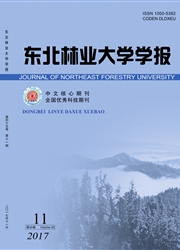

 中文摘要:
中文摘要:
以南京紫金山国家森林公园的6个景区为抽样总体,以GIS为分析平台,以2002年数字化的森林资源二类调查数据为主要信息源,在分析各个总体相关性、异质性、聚集性3个表面属性特征基础上,分别采用简单随机抽样、系统抽样、空间简单随机抽样、空间分层抽样、空间平衡抽样方法对单位面积蓄积量进行了抽样估计,并从抽样平均误差、抽样效率2个方面对各种抽样方法进行了评价,以确定不同表面属性特征总体的最化抽样设计方案。研究表明:对于空间异质性强、调查因子空间弱相关、近似于空间随机分布的调查区域,可以选择经典抽样、空间抽样多种方法;对于空间异质性较强、调查因子空间强相关、呈空间聚集分布的调查区域,可以优先考虑空间分层抽样;空间异质性较弱、调查因子空间弱相关、近似于空间随机分布的调查区域,则可以选择空间平街抽样。
 英文摘要:
英文摘要:
Six zones in Zijin Mountain National Forest Park were selected as sampling populations, and digital forest resource inventor, data in 2002 were used as the main information source. Surface attributes of the six populations were analyzed from three aspects of spatial correlation, heterogeneity and aggregation. Sampling estimation of volume per unit area was made by simple random sampling, systematic sampling, spatial simple random sampling, spatial stratified sampling and spatial balanced sampling. The optimal sampling design for the populations with different surface attributes was screened in terms of sampling average error and sampling efficiency. Results show that traditional sampling and spatial sampling methods are suitable for populations with strong heterogeneity, weak spatial correlation and approximate spatial random pattern; spatial stratified sampling method is the best for populations with strong heterogeneity, strong spatial correlation and aggregated spatial pattern; spatial balanced sampling method is appropriate for populations with weak heterogeneity, weak spatial con-elation and approximate random spatial pattern.
 同期刊论文项目
同期刊论文项目
 同项目期刊论文
同项目期刊论文
 期刊信息
期刊信息
